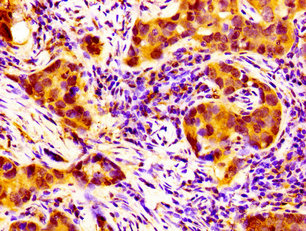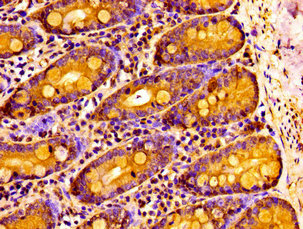NPAS2 Antibody
-
货号:CSB-PA860777LA01HU
-
规格:¥440
-
促销:
-
图片:
-
IHC image of CSB-PA860777LA01HU diluted at 1:100 and staining in paraffin-embedded human pancreatic cancer performed on a Leica BondTM system. After dewaxing and hydration, antigen retrieval was mediated by high pressure in a citrate buffer (pH 6.0). Section was blocked with 10% normal goat serum 30min at RT. Then primary antibody (1% BSA) was incubated at 4°C overnight. The primary is detected by a biotinylated secondary antibody and visualized using an HRP conjugated SP system.
-
IHC image of CSB-PA860777LA01HU diluted at 1:100 and staining in paraffin-embedded human small intestine tissue performed on a Leica BondTM system. After dewaxing and hydration, antigen retrieval was mediated by high pressure in a citrate buffer (pH 6.0). Section was blocked with 10% normal goat serum 30min at RT. Then primary antibody (1% BSA) was incubated at 4°C overnight. The primary is detected by a biotinylated secondary antibody and visualized using an HRP conjugated SP system.
-
Immunofluorescence staining of Hela cells with CSB-PA860777LA01HU at 1:133, counter-stained with DAPI. The cells were fixed in 4% formaldehyde, permeabilized using 0.2% Triton X-100 and blocked in 10% normal Goat Serum. The cells were then incubated with the antibody overnight at 4°C. The secondary antibody was Alexa Fluor 488-congugated AffiniPure Goat Anti-Rabbit IgG(H+L).
-
-
其他:
产品详情
-
产品名称:Rabbit anti-Homo sapiens (Human) NPAS2 Polyclonal antibody
-
Uniprot No.:Q99743
-
基因名:NPAS2
-
别名:Basic helix loop helix PAS protein MOP4 antibody; Basic-helix-loop-helix-PAS protein MOP4 antibody; bHLHe9 antibody; class E basic helix loop helix protein 9 antibody; Class E basic helix-loop-helix protein 9 antibody; FLJ23138 antibody; Member of PAS protein 4 antibody; Member of PAS superfamily 4 antibody; MGC71151 antibody; MOP4 antibody; Neuronal PAS domain containing protein 2 antibody; Neuronal PAS domain protein 2 antibody; Neuronal PAS domain-containing protein 2 antibody; Neuronal PAS2 antibody; NPAS2 antibody; NPAS2_HUMAN antibody; PAS domain containing protein 4 antibody; PAS domain-containing protein 4 antibody; PASD4 antibody
-
宿主:Rabbit
-
反应种属:Human
-
免疫原:Recombinant Human Neuronal PAS domain-containing protein 2 protein (644-763AA)
-
免疫原种属:Homo sapiens (Human)
-
标记方式:Non-conjugated
本页面中的产品,NPAS2 Antibody (CSB-PA860777LA01HU),的标记方式是Non-conjugated。对于NPAS2 Antibody,我们还提供其他标记。见下表:
-
克隆类型:Polyclonal
-
抗体亚型:IgG
-
纯化方式:>95%, Protein G purified
-
浓度:It differs from different batches. Please contact us to confirm it.
-
保存缓冲液:Preservative: 0.03% Proclin 300
Constituents: 50% Glycerol, 0.01M PBS, pH 7.4 -
产品提供形式:Liquid
-
应用范围:ELISA, IHC, IF
-
推荐稀释比:
Application Recommended Dilution IHC 1:20-1:200 IF 1:50-1:200 -
Protocols:
-
储存条件:Upon receipt, store at -20°C or -80°C. Avoid repeated freeze.
-
货期:Basically, we can dispatch the products out in 1-3 working days after receiving your orders. Delivery time maybe differs from different purchasing way or location, please kindly consult your local distributors for specific delivery time.
相关产品
靶点详情
-
功能:Transcriptional activator which forms a core component of the circadian clock. The circadian clock, an internal time-keeping system, regulates various physiological processes through the generation of approximately 24 hour circadian rhythms in gene expression, which are translated into rhythms in metabolism and behavior. It is derived from the Latin roots 'circa' (about) and 'diem' (day) and acts as an important regulator of a wide array of physiological functions including metabolism, sleep, body temperature, blood pressure, endocrine, immune, cardiovascular, and renal function. Consists of two major components: the central clock, residing in the suprachiasmatic nucleus (SCN) of the brain, and the peripheral clocks that are present in nearly every tissue and organ system. Both the central and peripheral clocks can be reset by environmental cues, also known as Zeitgebers (German for 'timegivers'). The predominant Zeitgeber for the central clock is light, which is sensed by retina and signals directly to the SCN. The central clock entrains the peripheral clocks through neuronal and hormonal signals, body temperature and feeding-related cues, aligning all clocks with the external light/dark cycle. Circadian rhythms allow an organism to achieve temporal homeostasis with its environment at the molecular level by regulating gene expression to create a peak of protein expression once every 24 hours to control when a particular physiological process is most active with respect to the solar day. Transcription and translation of core clock components (CLOCK, NPAS2, ARNTL/BMAL1, ARNTL2/BMAL2, PER1, PER2, PER3, CRY1 and CRY2) plays a critical role in rhythm generation, whereas delays imposed by post-translational modifications (PTMs) are important for determining the period (tau) of the rhythms (tau refers to the period of a rhythm and is the length, in time, of one complete cycle). A diurnal rhythm is synchronized with the day/night cycle, while the ultradian and infradian rhythms have a period shorter and longer than 24 hours, respectively. Disruptions in the circadian rhythms contribute to the pathology of cardiovascular diseases, cancer, metabolic syndromes and aging. A transcription/translation feedback loop (TTFL) forms the core of the molecular circadian clock mechanism. Transcription factors, CLOCK or NPAS2 and ARNTL/BMAL1 or ARNTL2/BMAL2, form the positive limb of the feedback loop, act in the form of a heterodimer and activate the transcription of core clock genes and clock-controlled genes (involved in key metabolic processes), harboring E-box elements (5'-CACGTG-3') within their promoters. The core clock genes: PER1/2/3 and CRY1/2 which are transcriptional repressors form the negative limb of the feedback loop and interact with the CLOCK|NPAS2-ARNTL/BMAL1|ARNTL2/BMAL2 heterodimer inhibiting its activity and thereby negatively regulating their own expression. This heterodimer also activates nuclear receptors NR1D1/2 and RORA/B/G, which form a second feedback loop and which activate and repress ARNTL/BMAL1 transcription, respectively. The NPAS2-ARNTL/BMAL1 heterodimer positively regulates the expression of MAOA, F7 and LDHA and modulates the circadian rhythm of daytime contrast sensitivity by regulating the rhythmic expression of adenylate cyclase type 1 (ADCY1) in the retina. NPAS2 plays an important role in sleep homeostasis and in maintaining circadian behaviors in normal light/dark and feeding conditions and in the effective synchronization of feeding behavior with scheduled food availability. Regulates the gene transcription of key metabolic pathways in the liver and is involved in DNA damage response by regulating several cell cycle and DNA repair genes. Controls the circadian rhythm of NR0B2 expression by binding rhythmically to its promoter. Mediates the diurnal variation in the expression of GABARA1 receptor in the brain and contributes to the regulation of anxiety-like behaviors and GABAergic neurotransmission in the ventral striatum.
-
基因功能参考文献:
- NPAS2 hypomethylation occurs at the early stage of PD and is a moderate biomarker for distinguishing PD patients from healthy subjects. PMID: 29353016
- NPAS2 has a critical role in HCC cell survival and tumor growth, which is mainly mediated by transcriptional upregulation of CDC25A. PMID: 28333141
- Aggregate genetic variation in circadian rhythm and melatonin pathways were significantly associated with the risk of prostate cancer in data combining GAME-ON and PLCO, after Bonferroni correction (ppathway < 0.00625). The two most significant genes were NPAS2 (pgene = 0.0062) and AANAT (pgene = 0.00078); the latter being significant after Bonferroni correction. PMID: 28699174
- Significantly, this study is the first to show that a variant copy number GGC repeat sequence in the NPAS2 clock gene associates with melanoma risk and which may be useful in the assessment of melanoma predisposition. PMID: 28799406
- CLOCK, ARNTL, and NPAS2 gene polymorphisms may have a role in seasonal variations in mood and behavior PMID: 26134245
- Genetic variations in NPAS2 might be a biomarker for a seasonal pattern in bipolar disorders. PMID: 25989161
- With whole-exome sequencing a novel mutation in NPAS2 was identified in a Turkish family with nonobstructive azoospermia. PMID: 25956372
- NPAS2 rs2305160 polymorphism does not appear to have any association with risk of chronic lymphocytic leukemia in our Pakistani population. PMID: 25227809
- distributions of allelic, genotypic, and haplotypic variants of NPAS2 (rs2305160 and rs6725296) were not significantly different between schizophrenic patients with and without RLS PMID: 24824748
- Two single nucleotide polymorphisms in RORA were associated with breast cancer in the whole sample and among postmenopausal women, and we also reported an association with CLOCK, RORA, and NPAS2 in the analyses at the gene level PMID: 24919398
- Functional rs1053096 and rs2305160 polymorphisms in the NPAS2 gene are associated with overall survival in transcatheter arterial chemoembolization-treated hepatocellular carcinoma patients. PMID: 24754267
- NPAS2, functioned as a potential tumor suppressor gene, could serve as a promising target and potential prognostic indicator for colorectal cancer. PMID: 24978311
- Variants in NPAS2 have been associated with seasonality and seasonal affective disorder, phenotypes that could reflect circadian rhythm disruption. PMID: 23449886
- Genetic variants of NPAS2 associate with seasonal affective disorder or winter depression. PMID: 22538398
- Convergent functional genomics allowed the identification of novel candidate genes, GRIK2 and NPAS2, involved in glutamatergic neurotransmission and the circadian rhythm, respectively, that are potentially associated with CFS. PMID: 21912186
- found a novel functional SNP (rs3739008) located at 3'UTR of NPAS2 and the C to T changing of the SNP may disrupt the binding of microRNA- (miR-) 17-5p and miR-519e to the 3'UTR of NPAS2 PMID: 21140207
- ARNTL and NPAS2 SNPs were associated with reproduction and with seasonal variation. PMID: 20368993
- Data demonstrate that NPAS2 is also a RORalpha and REV-ERBalpha target gene. PMID: 20817722
- A high level of NPAS2 expression was strongly associated with improved disease free survival & overall survival. The Ala/Ala, Ala/Thr, & Thr/Thr genotypes were also differentially distributed by tumor severity, as measured by TNM classification. PMID: 19649706
- A significant difference between patients with seasonal affective disorder (SAD) and controls is found for NPAS2 protein (471 Leu/Ser) indicating a recessive effect of the leucine allele on SAD susceptibility. PMID: 12655319
- the CLOCK(NPAS2)/BMAL1 complex is post-translationally regulated by cry1 and cry2 PMID: 16628007
- Our results demonstrate a robust association of the variant Thr genotypes (Ala/Thr and Thr/Thr) with reduced risk of non-Hodgkin's lymphoma. PMID: 17096334
- With autisitc disorder, haplotype analysis of two-marker haplotypes showed that in npas2 40 out of the 136 possible two-marker combinations were significant, with the best result between markers rs1811399 and rs2117714. PMID: 17264841
- a role of the circadian gene NPAS2 in human breast cancer, suggesting that genetic variations in circadian genes might be a novel panel of biomarkers for breast cancer risk. PMID: 17453337
- variations associated with seasonal affective disorder PMID: 17457720
- knockdown of NPAS2 significantly represses the expression of several cell cycle and DNA repair genes in breast and colorectal neoplasms. PMID: 18819933
- Variations in circadian genes are associated with serum levels of androgens and IGF markers, particularly NPAS2 rs2305160:G>A(Ala394Thr). PMID: 18990770
- The 1st list of direct transcriptional targets of NPAS2 comprises 26 genes that contain potential NPAS2 binding regions, 9 of which are involved in tumorigenesis. PMID: 19457610
显示更多
收起更多
-
亚细胞定位:Nucleus.
-
数据库链接:
HGNC: 7895
OMIM: 603347
KEGG: hsa:4862
STRING: 9606.ENSP00000338283
UniGene: Hs.156832
Most popular with customers
-
-
YWHAB Recombinant Monoclonal Antibody
Applications: ELISA, WB, IF, FC
Species Reactivity: Human, Mouse, Rat
-
Phospho-YAP1 (S127) Recombinant Monoclonal Antibody
Applications: ELISA, WB, IHC
Species Reactivity: Human
-
-
-
-
-
























